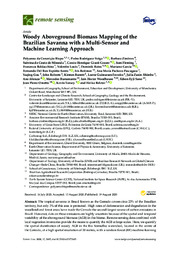Woody Aboveground Biomass Mapping of the Brazilian Savanna with a Multi-Sensor and Machine Learning Approach.
Woody Aboveground Biomass Mapping of the Brazilian Savanna with a Multi-Sensor and Machine Learning Approach.
Autoria: BISPO, P. da C.; RODRÍGUEZ-VEIGA, P.; ZIMBRES, B.; MIRANDA, S. do C. de; CEZARE, C. H. G.; FLEMING, S.; BALDACCHINO, F.; LOUIS, V.; RAINS, D.; GARCIA, M.; ESPIRITO-SANTO, F. D. B.; ROITMAN, I.; PACHECO-PASCAGAZA, A. M.; GOU, Y.; ROBERTS, J.; BARRETT, K.; FERREIRA, L. G.; SHIMBO, J. Z.; ALENCAR, A.; BUSTAMANTE, M.; WOODHOUSE, I. H.; SANO, E. E.; OMETTO, J. P.; TANSEY, K.; BALZTER, H.
Resumo: The tropical savanna in Brazil known as the Cerrado covers circa 23% of the Brazilian territory, but only 3% of this area is protected. High rates of deforestation and degradation in the woodland and forest areas have made the Cerrado the second-largest source of carbon emissions in Brazil. However, data on these emissions are highly uncertain because of the spatial and temporal variability of the aboveground biomass (AGB) in this biome. Remote-sensing data combined with local vegetation inventories provide the means to quantify the AGB at large scales. Here, we quantify the spatial distribution of woody AGB in the Rio Vermelho watershed, located in the centre of the Cerrado, at a high spatial resolution of 30 metres, with a random forest (RF) machine-learning approach. We produced the first high-resolution map of the AGB for a region in the Brazilian Cerrado using a combination of vegetation inventory plots, airborne light detection and ranging (LiDAR) data, and multispectral and radar satellite images (Landsat 8 and ALOS-2/PALSAR-2). A combination of random forest (RF) models and jackknife analyses enabled us to select the best remote-sensing variables to quantify the AGB on a large scale. Overall, the relationship between the ground data from vegetation inventories and remote-sensing variables was strong (R2 = 0.89), with a root-mean-square error (RMSE) of 7.58 Mg ha−1 and a bias of 0.43 Mg ha−1. View Full-Text
Ano de publicação: 2020
Tipo de publicação: Artigo de periódico
Unidade: Embrapa Cerrados
Palavras-chave: Biomassa, Carbono, Cerrado, Sensoriamento Remoto
Observações
1 - Por padrão são exibidas publicações dos últimos 20 anos. Para encontrar publicações mais antigas, configure o filtro ano de publicação, colocando o ano a partir do qual você deseja encontrar publicações. O filtro está na coluna da esquerda na busca acima.
2 - Para ler algumas publicações da Embrapa (apenas as que estão em formato ePub), é necessário ter, no celular ou computador, um desses softwares gratuitos. Sistemas Android: Google Play Livros; IOS: iBooks; Windows e Linux: software Calibre.
Acesse outras publicações
Acesse a Base de Dados da Pesquisa Agropecuária (BDPA) para consultar o acervo completo das bibliotecas da Embrapa.

